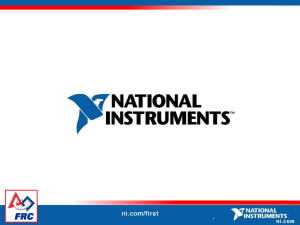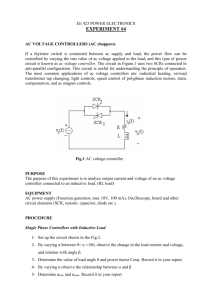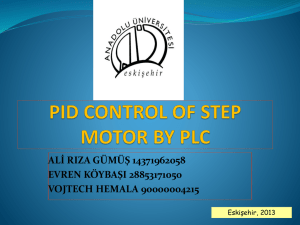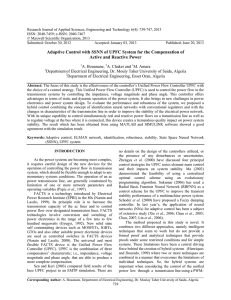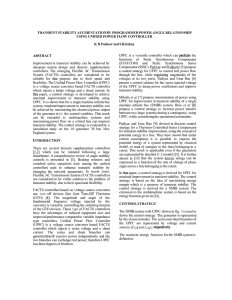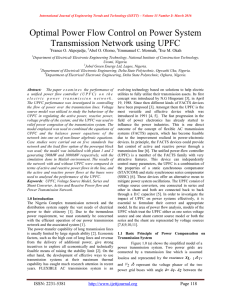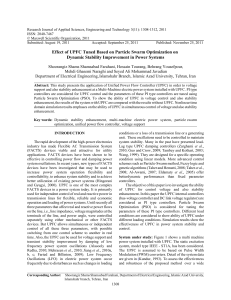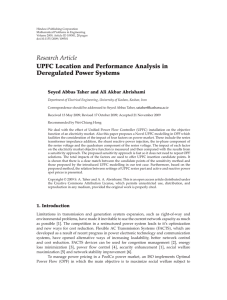intelligent control of flexible ac transmission systems using neural
advertisement
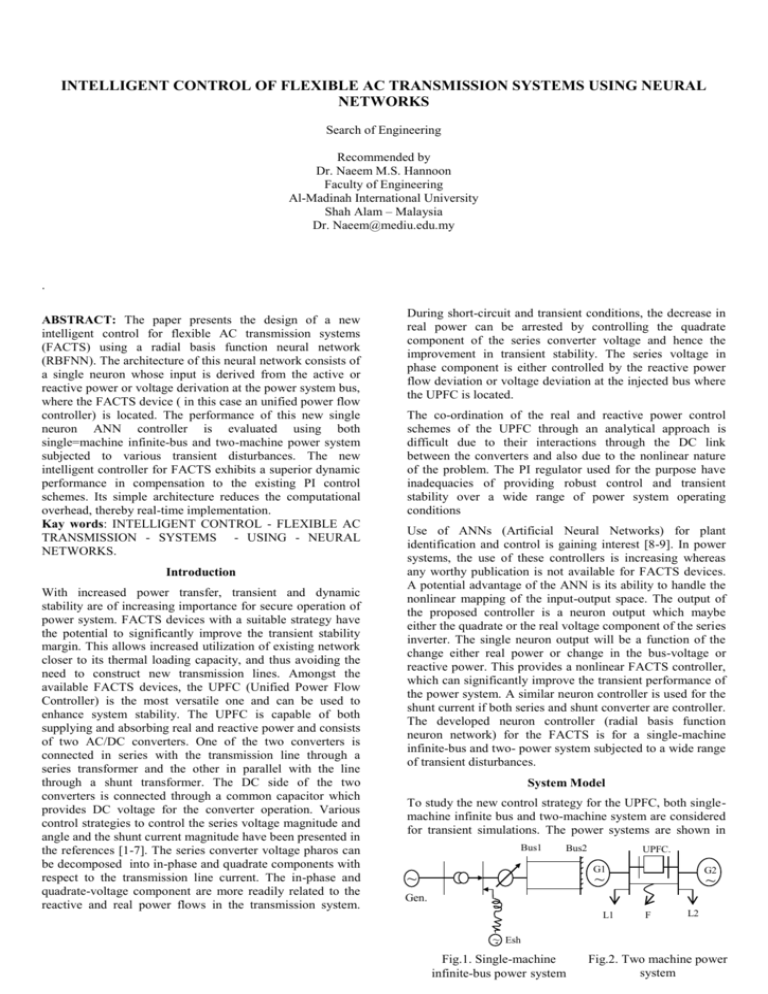
INTELLIGENT CONTROL OF FLEXIBLE AC TRANSMISSION SYSTEMS USING NEURAL NETWORKS Search of Engineering Recommended by Dr. Naeem M.S. Hannoon Faculty of Engineering Al-Madinah International University Shah Alam – Malaysia Dr. Naeem@mediu.edu.my . ABSTRACT: The paper presents the design of a new intelligent control for flexible AC transmission systems (FACTS) using a radial basis function neural network (RBFNN). The architecture of this neural network consists of a single neuron whose input is derived from the active or reactive power or voltage derivation at the power system bus, where the FACTS device ( in this case an unified power flow controller) is located. The performance of this new single neuron ANN controller is evaluated using both single=machine infinite-bus and two-machine power system subjected to various transient disturbances. The new intelligent controller for FACTS exhibits a superior dynamic performance in compensation to the existing PI control schemes. Its simple architecture reduces the computational overhead, thereby real-time implementation. Kay words: INTELLIGENT CONTROL - FLEXIBLE AC TRANSMISSION - SYSTEMS - USING - NEURAL NETWORKS. Introduction With increased power transfer, transient and dynamic stability are of increasing importance for secure operation of power system. FACTS devices with a suitable strategy have the potential to significantly improve the transient stability margin. This allows increased utilization of existing network closer to its thermal loading capacity, and thus avoiding the need to construct new transmission lines. Amongst the available FACTS devices, the UPFC (Unified Power Flow Controller) is the most versatile one and can be used to enhance system stability. The UPFC is capable of both supplying and absorbing real and reactive power and consists of two AC/DC converters. One of the two converters is connected in series with the transmission line through a series transformer and the other in parallel with the line through a shunt transformer. The DC side of the two converters is connected through a common capacitor which provides DC voltage for the converter operation. Various control strategies to control the series voltage magnitude and angle and the shunt current magnitude have been presented in the references [1-7]. The series converter voltage pharos can be decomposed into in-phase and quadrate components with respect to the transmission line current. The in-phase and quadrate-voltage component are more readily related to the reactive and real power flows in the transmission system. During short-circuit and transient conditions, the decrease in real power can be arrested by controlling the quadrate component of the series converter voltage and hence the improvement in transient stability. The series voltage in phase component is either controlled by the reactive power flow deviation or voltage deviation at the injected bus where the UPFC is located. The co-ordination of the real and reactive power control schemes of the UPFC through an analytical approach is difficult due to their interactions through the DC link between the converters and also due to the nonlinear nature of the problem. The PI regulator used for the purpose have inadequacies of providing robust control and transient stability over a wide range of power system operating conditions Use of ANNs (Artificial Neural Networks) for plant identification and control is gaining interest [8-9]. In power systems, the use of these controllers is increasing whereas any worthy publication is not available for FACTS devices. A potential advantage of the ANN is its ability to handle the nonlinear mapping of the input-output space. The output of the proposed controller is a neuron output which maybe either the quadrate or the real voltage component of the series inverter. The single neuron output will be a function of the change either real power or change in the bus-voltage or reactive power. This provides a nonlinear FACTS controller, which can significantly improve the transient performance of the power system. A similar neuron controller is used for the shunt current if both series and shunt converter are controller. The developed neuron controller (radial basis function neuron network) for the FACTS is for a single-machine infinite-bus and two- power system subjected to a wide range of transient disturbances. System Model To study the new control strategy for the UPFC, both singlemachine infinite bus and two-machine system are considered for transient simulations. The power systems are shown in Bus1 Bus2 UPFC. G1 ~ G2 ~ ~ Gen. L1 F L2 ~ Esh Fig.1. Single-machine infinite-bus power system Fig.2. Two machine power system Fig.1. & Fig.2. . rd The synchronous generator is represented by a 3 order machine model and the generator excitation system has a simple automatic voltage regulator (AVR). The series converter injected a variable voltage source VC and the shunt converter is a variable current is. 1. Neural Network based Controller for UPFC It is well known that a multi-layer feed forward neural network with back propagation (BP) training algorithm is the most widely used ANN model for nonlinear control of a power system. However, the PB algorithm does not have a mechanism to detect when the operating state of the power system falls in a region with no training data. This produces s serious drawback of the BP algorithm, as the operating condition covers a wide range of system and fault conditions. Recently researchers have begun to examine the use of radial basis function (RBF) network for nonlinear control of plants and systems as they offer a simple topological structure and give insight as to how learning proceeds in an explicit manner. Further for real-time implementation of a FACTS controller, a single neuron RBF neuron network (RBFNN) will be adequate. Fig.3. shows the structure of the RBFNN, where the hidden layer comprises a single neuron refereed to as the computing unit Hidden layer x Output layer x F(x) ΔP(k)is Δ P(k) ΔP(k)-ΔP(k-1 ) (2) The quadrate voltage component is used in equation (1) as it influences the real power error. In a similar way, the weight adjustment for the single neuron RBF controller to obtain the signal Vsp is done using the error surface p(k) as . q C1q Q(k ) C2q Q(k ) C3qVsp (k 1) (3) and Q(k) Qref Q1(k ) . Q(k ) Q(k ) Q(k 1) (4) Instead of reactive power deviation, the voltage deviation at bus-1 can be taken as a control input. Since an error surface is used to update the parameters of the controller any network training is not required for generating the control voltage components Vsp and Vsq. Further the constants C1p, C2p, C3p, etc. are to be chosen suitably for the best performance of UPFC in stabilizing power system oscillations. In case the PI regulator is used in controlling Vsp and Vsq, the equations are: Qref + Q - (x) Z-1 0 - C2q + + + + Fig.3. Single-neuron RBFNN structure C3q C1 q In order to utilize a limited knowledge of the power system dynamics to design the RBFNN controller for the series converter (control of voltage outputs Vsp and Vsq) a reinforcement method of weight adaption in used in this paper. Fig.4, shows the schematic diagram of the proposed controller for Vsp and Vsq respectively (Z-1 in the shift operator). Vsp and Vsq are expressed as V sp Vcd sin V q cos Vcq sin , and tan -1 i cd i cq Z-1 RBFN N Pref + - Z-1 In obtaining the control signal Vsq, the input to the signal neuron RBF controller is the real power deviation signal P and weight adjustment is done in using the error surface p(k) as p (k ) C1p P(k ) C2 p P(k ) C3 pVsq (k 1) plant P Vcd , Vcq and icd , icq are the d-q axes component of the injected series voltage and the line current ic. Vsp - C2p + + + + C3p C1 p Z-1 (1) in the above equation P(k ) Pref P1 (k ), P1 (k ) is the real power flowing into transmission line at the kth instant. The derivative term is RBFN N Vsq Fig. 4. RBFNN Controller plant Kiq Q, Vsp K pq P 2. Kip P Vsq K pp P (5) Fig. 8 shows the transient response for the 3-phase fault case from which it can be seen that the performance is found to be excellent in the case of control of both the converters of UPFC. The first swing excursions and settling time are improved using the control on both the converters. Computational Results The single-machine infinite-bus power system shown in Fig.1. and two machine power system in Fig.2. are taken for digital simulation studies. The UPFC control scheme consists of controlling voltage components Vsp and Vsq by using real and reactive power deviations or real power or voltage deviations. The current of the shunt converter is obtained from the power balance equations at every control instant. The following large disturbance cases are considered for evaluating the performance of these controllers: A. Fault Studies On Single-Machine Infinite-Bus Power system Case 1: P-Q control (only series) C1p=.15; C2p=.15; C3p= -.05; C1q=.01 ; C2q=.01 ; C3q= -1, Kpp=0.3 ; Kip=3; Kpp=.1; Kiq=1 The synchronous generator is assumed to operate at low power output condition (P=0.1 p.u, and Q=0.2 p.u.) and a 3 phase fault occurs near the infinite-bus. The fault is cleared after 0.1 sec. Of its inception and Fig. 5 shows the transient response of the system with a conventional PI regulator for the UPFC and the new single neuron RBF controller. From the results it can be seen that the significant first swing stability is achieved by using the new neural network controller in comparison to the conventional PI controller. The d.c. voltage excursions are also rapidly stabilized using the new controller and this is a very important criterion for successful operation of series and shunt voltage inverters. The operating level of the generator is then changed to a high power case with P = 1.4 p.u., and Q = 0.6 p.u. and a 3-phase fault is initiated near the infinite-bus and cleared after 0.1 second of its inception. Fig. 6 shows transient response of the power system for this operating condition with either PI or the RBF neural controller. From the response, it can be ascertained that the electromechanical are damped very quickly in case of the new controller proving its superiority over the conventional PI controllers used for the UPFC control. Case 3 : Both series and shunt control C1p=.21; C2p=.21; C3p= -.03; C1i=.01; C2i=.01, C3i= -1 In this case the effectiveness of both series and shunt converter controls of the UPFC are tested to damp electromechanical oscillations of a single-machine infinitebus power system subjected to 3-phase fault. The power loading of the generator is kept at P = 1.4 p.u. and Q = 0.6 p.u. and the real power deviation is used to control Vsq (Vsp is not controlled) for the series converter. The shunt converter on the other hand is used to control the shunt current I Q from the UPFC-bus voltage deviation. The error surface used for this control is . i C1i V (k ) C 2i V (k ) C 3i iQ (k 1). B. Two-Machine Power System The 2-machine power system shown in Fig. 2 is used to study the interaction between the generators with the UPFC located on one of the lines of a parallel transmission system. The real and reactive power injections at bus 1 are 0.9082 p.u. and 0.4186 p.u. and at bus 2 are 0.3634 p.u. and 0.3435 p.u. respectively. A 3-phase fault is initiated at the point F and cleared in 0.1 sec. For the UPFC control, a single-neuron RBF controller is used as in the case of single-machine infinite-bus. A modulating signal based on either the speed deviation between the two generators or the UPFC bus angle is used to improve the damping. In that case the signal P (change in real power in the transmission line after UPFC from the reference) is to be replaced by P + K. (1 - 2) Fig. 9 shows the performance of the 2-machine power system in which the RBFNN controller is found to provide significant improvement in damping inter area oscillations in comparison to the conventional PI regulators. The first swing overshoot is significantly reduced in case of the new UPFC controller. 5. Conclusions This paper presents a new single neuron Radial Basis Function Controller (RBFNN) for the UPFC control in a single machine-infinite-bus and two-machine power system. The single neuron controller uses either the real and reactive power deviations or the real power and voltage deviations at the UPFC injection bus to provide the magnitude and phase angle of the variable voltage source for the series converter. The shunt converter current can be similarly controlled using a RBFNN and the UPFC with both series and shunt controls provides the best transient stability performance of the power system. The parameters of the single neuron RBF controller are adjusted using an extended Kalman filter. More than one neuron has also been used for providing control voltages, however, the improvement in transient stability performance has been minimal in comparison to the single neuron case. The simple architecture of the controller has the potentiality of implementation on a DSP chip in real-time environment. REFERENCES 1. L. Gyugyi, C.D. Schauder, S.L. Torgerson and A. Edris, “The Unified Power Flow Controller: A new approach to Power Transmission Control”, IEEE Trans. On Power Delivery, Vol. 10, No. 2, 1995, pp. 1088-1097. 2. L. Gyugyi, “Unified Power flow concept for flexible AC Transmission systems”, IEE Proc.-C, Col. 139, No.4, 1992, pp. 323-332. 3. C.D. Schauder and H. Mehta, “Vector Analysis and Control of Advanced Static VAR Compensator”, IEE Proc.C, Vol. 140, No. 4, 1993, pp. 299-306. 4. M. Noorzian, L. Angquist, M. Ghandari and G. Anderson, “Improving Power System Dynamics by SeriesConnected FACTS Devices”, IEEE Trans. on Power Delivery, Vol. 12, No. 4, 1997, pp. 1635-1641. 5. M. Noorzian and G. Anderson, “Damping of Power System by Controllable components”, IEEE Transactions on Power Delivery, Vol. 9, No. 4, 1994, pp. 2046-2054. 6. K. R. Padiyar and A. M. Kulkarni, “Control design and simulation of Unified Power flow controller”, IEEE Trans. on Power Delivery, Paper PE-172-PWRD-0-12-1997. 7. S. Limyingcharoen, U. D. Annakkage and N. C. Pahalawaththa, “Fuzzy logic based Unified Power flow controllers for transient stability improvement”, IEEE Proc.C, Vol. 145, No. 3, 1998, pp. 225-232. 8. K. S. Narendra, K. Parthasarathy, “Identification and control of dynamical systems using Neural Networks”, IEEE Trans. on Neural Networks. Vol. 1, No. 1, March 1990, pp. 4-27. 9. K. G. Narendra, K. Khorasani, V. K. Sood, R. V. Patel, “Intelligent Current Controller for HVDC Transmission Link”, IEEE Trans. on power Systems, Vol. 13, No. 3, Aug. 1998, pp. 1076-1083.






